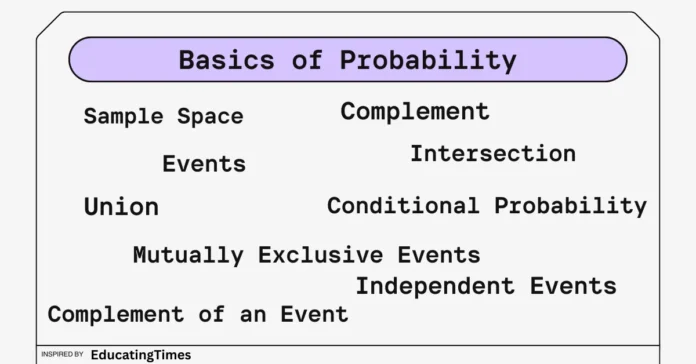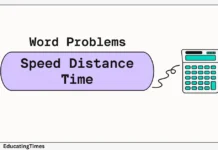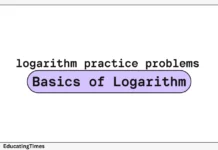| Concept | Definition | Formula | Example |
|---|---|---|---|
| Sample Space | The set of all possible outcomes of an experiment | N/A | Rolling a fair six-sided die: {1, 2, 3, 4, 5, 6} |
| Event | A subset of the sample space representing an outcome | N/A | Rolling an even number: {2, 4, 6} |
| Probability | The likelihood of an event occurring | P(A) = Number of favorable outcomes / Total outcomes | P(rolling a 3) = 1/6 |
| Complement | The event that does not occur | P(A’) = 1 – P(A) | P(not rolling a 3) = 1 – 1/6 = 5/6 |
| Union in Probability | The event that at least one of two events occurs | P(A ∪ B) = P(A) + P(B) – P(A ∩ B) | P(rolling an even number or a prime number) = P(even) + P(prime) – P(even ∩ prime) |
| Intersection in Probability | The event that both events occur | P(A ∩ B) = P(A) × P(B) | P(rolling an even number and a prime number) = P(even) × P(prime) |
| Mutually Exclusive Events | Two events that cannot occur simultaneously | P(A ∩ B) = 0 | Rolling an odd number and an even number |
| Independent Events | Two events that do not affect each other’s likelihood | P(A ∩ B) = P(A) × P(B) | Tossing a coin and rolling a die |
| Conditional Probability | The probability of an event given another event | P(A | B) = P(A ∩ B) / P(B) |
Sample Space
A bag contains 3 red balls and 2 green balls. What is the sample space for selecting 2 balls from the bag without replacement?
Solution:
The sample space for selecting 2 balls without replacement from a bag containing 3 red balls and 2 green balls is given by all possible combinations of 2 balls that can be selected from the 5 total balls in the bag. Therefore, the sample space can be written as:
S = {(R1, R2), (R1, G1), (R1, G2), (R2, G1), (R2, G2)}
where R1 and R2 represent the two red balls, G1 and G2 represent the two green balls, and the parentheses indicate the order in which the balls were selected.
Event:
A dice is rolled. Find the event that a number less than 3 is rolled.
Solution:
The event “rolling a number less than 3” can be defined as the set of all outcomes in the sample space S = {1, 2, 3, 4, 5, 6} that satisfy this condition. Therefore, the event can be written as:
A = {1, 2} This event represents the outcome of rolling either a 1 or a 2 on the dice.
Probability
A bag contains 5 red marbles and 7 blue marbles. If one marble is selected at random, what is the probability of selecting a red marble?
Solution:
The probability of selecting a red marble can be calculated as the ratio of the number of red marbles to the total number of marbles in the bag. Therefore, the probability is:
P(Red) = 5/12 This means that there is a 5/12 chance of selecting a red marble from the bag.
Also Practice – Probability with Replacement and without Replacement
Complement
A deck of cards is shuffled and one card is drawn. Find the complement of the event “drawing a face card”.
Solution:
The complement of the event “drawing a face card” is the event “drawing a non-face card”, which includes all cards that are not face cards (i.e. all cards except the Jacks, Queens, and Kings). Since there are 12 face cards in a deck of 52 cards, the number of non-face cards is:
52 – 12 = 40 Therefore, the probability of drawing a non-face card is:
P(Non-face) = 40/52 = 10/13
Union
A bag contains 4 red balls, 3 green balls, and 2 blue balls. If one ball is selected at random, what is the probability of selecting a red or green ball?
Solution:
The event “selecting a red ball” can be denoted as A, and the event “selecting a green ball” can be denoted as B. The union of these events is the event “selecting a red or green ball”, which can be denoted as A ∪ B. The probability of this event can be calculated as:
P(A ∪ B) = P(A) + P(B) – P(A ∩ B)
where P(A) is the probability of selecting a red ball, P(B) is the probability of selecting a green ball, and P(A ∩ B) is the probability of selecting a ball that is both red and green (which is 0 in this case, since no ball can be both red and green). Therefore, the probability of selecting a red or green ball is:
P(A ∪ B) = P(A) + P(B) = 4/9 + 3/9 = 7/9 This means that there is a 7/9 chance of selecting a red or green ball from the bag.
Intersection:
A bag contains 6 red marbles and 8 blue marbles. If two marbles are selected at random without replacement, what is the probability of selecting two red marbles?
Solution:
The event “selecting a red marble on the first draw” can be denoted as A, and the event “selecting a red marble on the second draw, given that a red marble was selected on the first draw” can be denoted as B. The intersection of these events is the event “selecting two red marbles”, which can be denoted as A ∩ B. The probability of this event can be calculated as:
P(A ∩ B) = P(A) × P(B|A)
where P(A) is the probability of selecting a red marble on the first draw, and P(B|A) is the probability of selecting a red marble on the second draw, given that a red marble was selected on the first draw. Since the first marble is not replaced, there are 5 red marbles and 13 total marbles remaining in the bag for the second draw. Therefore, the probability of selecting a red marble on the second draw, given that a red marble was selected on the first draw, is:
P(B|A) = 5/13 Therefore, the probability of selecting two red marbles is:
P(A ∩ B) = P(A) × P(B|A) = (6/14) × (5/13) = 15/91
Conditional Probability
In a bag, there are 6 red marbles and 4 blue marbles. Two marbles are drawn at random without replacement. What is the probability of selecting a red marble on the second draw, given that a blue marble was selected on the first draw?
Solution:
The event “selecting a blue marble on the first draw” can be denoted as A, and the event “selecting a red marble on the second draw, given that a blue marble was selected on the first draw” can be denoted as B. The conditional probability of B, given A, can be denoted as P(B|A). The conditional probability can be calculated using the formula:
P(B|A) = P(A ∩ B) / P(A)
where P(A) is the probability of selecting a blue marble on the first draw, and P(A ∩ B) is the probability of selecting a blue marble on the first draw AND a red marble on the second draw. Since the first marble is not replaced, there are 9 total marbles remaining in the bag for the second draw, of which 6 are red and 3 are blue. Therefore, the probability of selecting a blue marble on the first draw is:
P(A) = 4/10
To calculate the probability of A ∩ B, we need to consider that there are 6 red marbles and 4 blue marbles in the bag, but one blue marble has already been selected. Therefore, there are only 3 blue marbles remaining in the bag for the second draw. Therefore, the probability of selecting a red marble on the second draw, given that a blue marble was selected on the first draw, is:
P(A ∩ B) = (4/10) × (6/9) = 8/45
Therefore, the conditional probability of selecting a red marble on the second draw, given that a blue marble was selected on the first draw, is:
P(B|A) = P(A ∩ B) / P(A) = (8/45) / (4/10) = 4/9
Mutually Exclusive Events
A card is drawn at random from a standard deck of 52 playing cards. What is the probability of selecting a spade or a queen?
Solution:
The events “selecting a spade” and “selecting a queen” are not mutually exclusive, as there is one card (the queen of spades) that is both a spade and a queen. Therefore, we need to use the formula for the probability of the union of two events:
P(A ∪ B) = P(A) + P(B) – P(A ∩ B)
where A is the event of selecting a spade, B is the event of selecting a queen, and A ∩ B is the event of selecting the queen of spades. The probability of selecting a spade is 13/52, the probability of selecting a queen is 4/52, and the probability of selecting the queen of spades is 1/52. Therefore, the probability of selecting a spade or a queen is:
P(A ∪ B) = P(A) + P(B) – P(A ∩ B) = (13/52) + (4/52) – (1/52) = 4/13
Independent Events
A fair six-sided die is rolled twice. What is the probability of rolling a 3 on both rolls?
Solution:
The probability of rolling a 3 on each roll is 1/6. Since the rolls are independent (the outcome of the first roll does not affect the outcome of the second roll), we can use the multiplication rule of probability to calculate the probability of rolling a 3 on both rolls:
P(3 on both rolls) = P(3 on first roll) × P(3 on second roll) = (1/6) × (1/6) = 1/36
Also Practice – Permutation and Combination
Complement of an Event
A multiple-choice test has 20 questions, each with 4 choices. If a student guesses randomly on each question, what is the probability that the student gets at least 10 questions correct?
Solution:
The probability that the student guesses correctly on any given question is 1/4. Since the student is guessing randomly, the outcome of each question is independent of the others. Therefore, we can model the number of correct guesses using a binomial distribution, where n = 20 (the number of trials) and p = 1/4 (the probability of success on each trial). Let X be the number of correct guesses. Then, the probability that the student gets at least 10 questions correct can be calculated as:
P(X ≥ 10) = 1 – P(X < 10) = 1 – P(X ≤ 9)
We can use the complement rule to calculate P(X ≤ 9) as:
P(X ≤ 9) = Σ P(X = k) for k = 0 to 9
where P(X = k) is the probability of getting k questions correct. Using the binomial distribution formula, we can calculate these probabilities as:
P(X = k) = (20 choose k) × (1/4)^k × (3/4)^(20-k)
Using a calculator or a computer program, we can calculate:
P(X ≤ 9) = 0.929
Therefore, the probability that the student gets at least 10 questions correct is:
P(X ≥ 10) = 1 – P(X < 10) = 1 – 0.929 = 0.071











